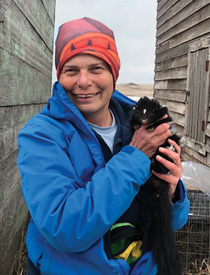
Integrative Ecology
October 10, 2022

Image courtesy of Merav Ben-David
Professor Merav Ben-David tackles complex ecological questions with a multifaceted approach.
By Micaela Myers
Zoology Professor Merav Ben-David was an integrative ecologist long before the term became popular — meaning that she approaches her wildlife and ecological research holistically.
“You can’t understand what’s happening if you have a narrow perspective or study just one species,” she says. “Systems are complicated. You have to look at each question from multiple angles using multiple tools.”
Ben-David earned her bachelor’s and master’s degrees from Tel Aviv University and her doctorate at the University of Alaska. She joined the University of Wyoming in 2000. Her research revolves around the interactions among animal behavioral ecology, population dynamics and ecosystem function.
For example, her team just completed a project in Washington’s Olympic National Park in conjunction with the Makah Tribe. The Lake Ozette sockeye salmon has been on the endangered species list for over 30 years, and all efforts to restore it have failed. The tribe wanted to know if river otters were part of the problem.
“We looked at the otters, how they use the landscape, how they feed and what their physiological and energetic needs are,” Ben-David says. “It’s a complicated multifaceted project. It showed that otters have little effect on the fish.”
Ben-David developed her love of animals and nature growing up on a small farm in Israel.
“You talk to wildlife biologists, and we all love animals — that’s our passion,” she says. She wants her students to also experience that passion and finds that the best way to teach them is hands-on in the field.
“I build my entire Wildlife Ecology and Management class around a research project,” Ben David says. “We study least chipmunks, and every year the class chooses the research question.”
Chipmunks are abundant, easy to catch, hardy and interesting, making them a perfect species for her students to study. They conduct habitat evaluations and trap, mark and measure the chipmunks. Then the students begin to ask questions and narrow in on a topic to study. The students also help write an annual report for the Wyoming Game and Fish Department and present the study on campus.
Past classes explored how climate change affects chipmunk abundance, how chipmunk density affects their birth and death rates, whether chipmunks use sagebrush habitat on a temporary basis, and the effects of precipitation on reproductive timing and success, among others.
The course teaches students many valuable skills they’ll need as wildlife biologists and managers.
Ben-David has learned so much from this educational tool that chipmunks are now part of her research portfolio, leading to new questions on brain function, memory and learning that she will explore with her neuroscience colleagues at UW.
She says, “If you start looking at a problem from multiple angles, it opens up a whole new world.”
